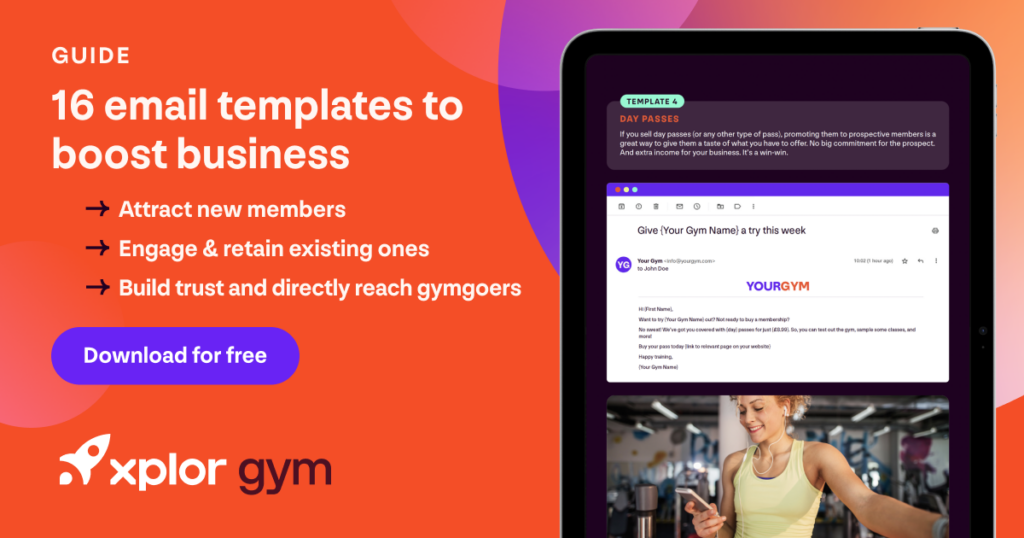If you’re considering opening your own fitness club or investing in a gym business, you’ve likely put a lot of thought into how profitable they can be (naturally!) Or perhaps you already own a gym and would like to increase its profitability.
Recent research on the fitness and health market has revealed that Australians spent up to $3.5 billion on fitness clubs and gyms in 2023, which equates to one in five Australians over 18 having a gym membership. This means that memberships alone bring in significant income – but what can you do to increase gym profitability beyond this?
Hold onto your sweatbands because we’ve done the digging for you. Read on for our in-depth look at how profitable gyms can be, what factors can influence it, and tips on boosting your own gym’s profitability.
Run a profitable gym business
Running a profitable gym business starts with the right gym management software. All in-one software like Xplor Gym. So, you have access to awesome features that help you reliably collect revenue and so much more!
What does ‘profitability’ mean?
Before we get stuck in, let’s clarify what it means to have a profitable business, because it doesn’t just mean you’ve got money coming in.
There’s a significant difference between profit and profitability:
- Profit = the amount of money your gym business makes after paying expenses. It’s an absolute number (for example, $100,000)
- Profitability = the percentage of revenue that you get to keep. It’s a relative number (for example, 10%)

Profitability metrics
To measure profitability, there are 2 metrics to pay attention to:
- Gross profit margin
- Measures the percentage of revenue left once you’ve covered costs involved in providing goods and services
- Important as it’s used to pay other expenses like rent, insurance, marketing, etc.
- Net profit margin
- Measures the percentage of revenue left after you’ve paid all business costs
- Important as it’s what a business gets to keep, reinvesting in growth and/or paying out to investors
Measuring profitability
Okay so this stuff can be a bit mind-boggling for many people but stay with us! First you need to work out what your profit is. Note that the approach is different between gross and net profit margin.
1. Calculate gross profit margin
Start by working out gross profit:
Gross profit = revenue – cost of sales expenses only
Then calculate gross profit margin:
Gross profit margin = gross profit x 100
2. Calculate net profit margin
Start by working out net profit:
Net profit = revenue – all expenses
You can calculate net profit pre- or post-taxes. If you’re calculating post-taxes, subtract taxes as part of all other expenses.
Now calculate net profit margin:
Net profit margin = net profit x 100
Together, these metrics can be used to assess how profitable gym businesses are. If all of that seemed like hieroglyphs, rest assured you’re not alone. Just be sure to harness the powers of an accountant or numbers wiz to help you work it all out.
How do gyms make money?
Now that we’ve covered profitability and the metrics you need to measure it, let’s look at the different ways that gyms make money.
This list of 10 ways gyms make money is comprehensive, but not complete. There are always new and creative ways to bring in revenue! Perhaps this list will spark ideas for generating additional revenue for your business.
#1 Membership fees
Memberships are essential to the vast majority of gyms and fitness clubs. These fees often make up the largest proportion of revenue.
There are many different types of memberships offered by gyms and they usually have one thing in common: they attract recurring, predictable revenue into the business.
According to Canstar Blue, in 2023 Aussies spent an average of $62 per month on gym memberships. Obviously, this fee differs between gyms and locations.
Membership pricing strategy
Go deeperMaster membership pricing with this guide to setting the right prices for your business.
Read now#2 Joining fees
Sometimes called admin fees, a joining fee is normally collected when a new prospect signs up for a membership. Typically this will be $20 to $40, for luxury clubs it can be much higher.
These fees are an important source of revenue for many gyms. Normally they’re used to cover:
- The cost of attracting a new member
- The work created to get a member onboarded
- The risk of a member cancelling during or soon after onboarding when costs have already been incurred
These fees can also encourage members to stick with a club for longer as they’ve paid this cost to join.
#3 Passes and casual access
The vast majority of gyms and fitness clubs also offer some form of casual access for gymgoers without a membership package. These are suitable for those who only want to visit occasionally, are visiting your area, or don’t want to commit to a full membership just yet.
The most common forms are day passes or casual pay-as-you-go ‘on the door’ access. Some clubs will also offer weekly or monthly passes.
This is a great way to bring in extra revenue and help some gymgoers make the decision to sign up to a membership package. Plus, pay-as-you-go access and day pass prices can help qualify the cost of a full membership.
#4 Group fitness classes
Classes are often included in the cost of a membership. And they can also be a great way to generate additional revenue.
Make them chargeable for non-members and even sell bundles of premium classes that members can choose to subscribe to.

#5 Personal training
Most gyms will offer personal training in some way. Personal trainers (PTs) help members get more from their membership investment with training programmes and coaching to reach their goals.
Exact approaches and business models for personal training do differ. Generally, there are 2 ways to work with PTs and generate revenue:
- Let self-employed PTs use your gym to train their clients (typically your members) and collect a fee from these PTs
- Employ PTs and have members pay your gym for sessions (either on a by-session or in bundles of sessions)
#6 Digital fitness services
Digital fitness services grew rapidly during the COVID-19 pandemic. And while many gymgoers were starting to look for digital solutions from gyms before this time, more are doing so now.
Digital fitness is a very broad term! There are lots of ways that gyms can make money by providing these services.
Examples include:
- Offering digital only membership packages with access to on-demand classes and other home workout options
- Selling digital training plans that members can follow in-club and elsewhere
- Setting your PTs up to provide virtual PT services to non-members
#7 Food, drink and nutritional supplements
Many gyms and fitness clubs make extra revenue by selling food and/or drink on site.
That could mean setting up a café with seating for members so members can sit down and catch up with each other. Or selling food and drink at reception/your shop to take away. Alternatively, some clubs install vending machines for self-service.
The key is making sure your margins and volumes make the effort of selling food and drink worth it.
Building on this, some gyms will choose to sell nutritional supplements for members to purchase. For example, protein powder, energy drinks, and greens powders.
These could be available for one-off purchase or as packages recommended for individual members. Make sure you source any supplements carefully to choose high quality, effective products.
#8 Fitness clothing & products
Similarly, another way gyms make money is by selling fitness clothing and products. Who doesn’t love a bit of merch!
Think t-shirts, socks, exercise mats, water bottles, and more. If you’re selling items in-club look for items that members will need for a workout and may have left at home.
Many gym businesses will have branded merchandise for sale. This helps you make extra money. And increases the reach of your brand with members wearing or carrying items outside of your club.
You could even set up an online store to sell and ship your branded merchandise.
#9 Events
Some gyms will run paid for events to bring in extra revenue. These could be open to anyone or just for members and could take place in-club or somewhere else.
When executed well, events can:
- Create a new revenue stream
- Boost awareness, attracting user-generated content (UGC) on social media
- Build accountability with members which can encourage them to keep showing up
- Create community (thus strengthening connection to your club)
- Enrich the member experience with something that’s not available elsewhere
- Attract new members
Examples of fitness events include:
- Charity quizzes
- Marathon fitness classes
- Pop-up classes
- Wellbeing workshops
- Educational workshops and seminars for personal trainers
13 challenge ideas
Go deeperExplore 13 ideas for fitness challenges that your members will love.
Explore now#10 Additional services
Many gyms are finding new ways to make money by introducing new services that address health and wellbeing more holistically. That usually means bringing in employees with specialist knowledge, skillsets and qualifications.
Examples of services you could offer include:
- Nutrition plans
- Sports therapy
- Massage therapy
- Meditation and breathwork sessions

What factors can impact gym profitability?
Now that we’ve covered some of the ways that money flows into a gym, let’s address the factors that can influence that flow.
How profitable gyms are will really depend on the exact circumstances of each business. There’s no guarantee of profitability. Generally, your profit margins will be somewhere between 10-30%:
- Franchise gyms often have the lowest profit margins, benefiting instead from established business models
- Larger gym chains tend for have the highest profit margins, benefiting from scale that offsets high operating costs
- Small independent gyms usually have a profit margin somewhere between franchise gyms and larger gym chains. Benefiting from lower fixed costs, challenged by limited member numbers
Here are 6 factors that can influence the profitability of your gym.
#1 Type of fitness facility
What type of fitness facility is your gym? This will impact your potential for profit. Different types of facilities need different levels of investment. And pricing models differ too.
Here’s what to keep in mind for common types of fitness businesses:
Budget gyms
If you’re running a budget gym, you’ll need to offer services and equipment at a low price point. You likely attract members looking for affordable access to a good quality workout experience.
Typically, budget gyms take a high volume, low margin approach to pricing – attracting as many members as practically possible. Typically, this means charging members $50 a month or lower.
This business model requires investing in plenty of equipment and consistent marketing and signing up new members. Making the most of gym automation where you can will help to keep costs low.
Premium (and super premium) gyms
At the opposite end, if you want to provide a high-end gym experience, you’ll be able to charge a high price point.
As well as providing a luxury workout environment with the best personal trainers and equipment, you’ll need to make sure every touchpoint is high quality to create an exclusive, personalised experience that members are happy to splash out on.
This type of fitness facility means investing in the best of the best equipment, tech, staff, facilities, and more. You’ll need to continuously invest more than other types of facilities.
Margins on memberships need to be higher to remain profitable and add-on spend can be invaluable in building profitability.
Mid-market gyms
In the middle are mid-market gyms and fitness clubs. With high operating costs justifying higher membership fees, more businesses now fit in this category.
To build a profitable mid-market gym business, you’ll need to offer more and/or superior facilities and services compared to budget gyms. And membership fees should be kept at a moderate price point.
Target members looking to trade up from a budget experience. Providing a higher-quality gym with more attention and advice, plus more facilities and activities. Plus, target members looking to trade down from premium clubs.
#2 Location, location
The profitability of your gym will be impacted by your location, which impacts:
- How much you can charge – a budget gym in central Melbourne can (usually) charge more than a budget gym in a rural town
- Operating costs – the cost of renting or purchasing a commercial property will differ depending on where you are. Plus, other costs can differ (for example, staffing costs, cleaning costs, maintenance costs)
- Potential to sign up members – this can impact profitability in two ways. Firstly, the demographics of potential members nearby can impact what they are looking for from a gym and at what price. And secondly, if your gym is convenient to use and in an area with a large population or high footfall, you’ll have the potential to sign up a higher number of members
Number of locations
The number of locations can impact how profitable gyms are. Those with more than one location have more potential to be profitable.
If your gym business operates multiple clubs, you’ll have the opportunity to benefit from economies of scale, meaning you can negotiate better deals with suppliers and partners. Plus, with the right processes and tech you can streamline operations to reduce repetition across locations by sharing resources.
As you invest in gym branding and grow your presence, you’ll benefit from brand recognition to attract new members faster.
You can also give members the benefit of holding a membership with access across multiple locations which justifies a higher price point.
#3 Business maturity
It’s only natural for people to trust a business that has more experience and longevity in the industry over the new kid in town, which can affect your new member intake.
Also, if you’ve been open for some time, you’re more likely to have paid off some of the costs incurred in setting up your business. And therefore, are more likely to have reached profitability.
#4 Operations
If you can run your gym business efficiently in every area, you’ll have better control over how profitable your business is. Strong processes that avoid waste (including wasted time), will help you maximise results and take action in the right places.
Operational costs can also impact profitability. If you’re overspending on utilities, staffing, equipment leasing, or anything else, you’ll soon find profitability takes a hit. Likewise, when costs are high due to external factors, you’ll need to adjust take actions to avoid shrinking profit margins.
#5 Revenue
Though it seems obvious, it must be said: the higher your revenue and the lower your operating costs, the higher your profitability is likely to be.
Recurring revenue from memberships is essential for most gyms and fitness clubs. And if you can find other ways to make money, you’ll grow revenue coming in and reduce reliance on membership fees alone. This can boost profitability.
#6 Debt
If your gym business has a high level of debt that needs paying off, your profit margins may be impacted. Keep debt levels manageable and profitability will come sooner.
How to increase your gym’s profitability
Just as there are plenty of factors that can influence your gym’s profitability, there are also many ways to increase it!
#1. Review your membership pricing
Profitable gym businesses will regularly review membership pricing. Review your pricing annually (or more frequently) and consider if you’re charging members correctly based on:
- Value provided – has this changed at all? Have you added anything new or made improvements?
- Competitiveness – how has the competition locally changed? How does this impact your position in the market?
- Type of business – has this changed at all?
- Demographics of your membership base – has this changed at all? How price sensitive are they?
- Operating costs – how have these changed?
Often you may decide to increase membership pricing to maintain and/or boost profitability. This can be a delicate matter so a careful approach is essential. Communicate increases well in advance, highlight the value you deliver and any improvements made.
“With the correct communication and a bit of time, the impact isn’t as big as people think. And that’s because with a bit of perspective everything else is going up so why as an industry shouldn’t we charge what we deserve to charge.”
Dave Alstead, Commercial Director, Xplor Gym
You may also want to add new membership packages and options to better cater to member demands. Having new options available can help you win and retain members – all increasing profitability.
#2. Win more new members
If you want to increase profitability, attracting more new members to your business can help. If you can continuously sign up new members each week, you’ll potentially be able to grow membership revenue.
Let your members do your marketing
Go deeperAttracting new members can be expensive. Take advantage of the low cost power of word of mouth marketing with an attractive refer-a-friend programme.
Get started#3. Increase member retention & value
It can be anywhere from 5-25 times more expensive to win a new member than to retain an existing one. And if you can increase retention rates by 5%, you could see profits increase by as much as 25-95%.
The importance of member retention shouldn’t be underestimated when you’re looking to boost profitability. If you can cut attrition (number of members leaving) and increase retention (the amount of time members stay with you), you’ll increase member life time value (LTV).
What is life time value (LTV)?
TipLTV is an estimate of the average revenue a member will generate for your gym throughout their membership.
Get 11 strategies to increase gym member retention.#4. Expand your core offering
Another way to increase the profitability of your gym business is to find new sources of revenue. That might mean adding new services or products.
For example:
- Offer day, week, and monthly passes to let non-members visit your gym
- Introduce bolt-ons for courses that members can choose to add to enhance their existing membership package
- Expand your PT services
- Sell food, drink, fitness products, and more in your club
- Partner with specialists to provide services like nutrition plans for members
- Run events and challenges (which we covered earlier)
#5 Invest in marketing & partnerships
There are many ways that marketing can help you increase the profitability of your gym business.
Start by building a gym brand that gymgoers trust and that helps you command a higher price. Then consider your overall marketing strategy and build a plan packed with gym marketing campaigns that’ll help you reach your goal of becoming more profitable.
Creating partnerships with local businesses, influencers, and other organisations can play an integral part in marketing your gym. You’ll reach new members and can even build out your offering with the right partners.

#6 Make operational improvements
Streamlined, efficient processes across your business will save you time and money, ultimately boosting your bottom-line!
Start by using the gym reporting software functionality within your gym software to identify the biggest opportunities for improvement. For example, if you are seeing a high percentage of members cancel early on in their membership, focus on that.
Look at what’s causing the problem and work out if you (and your team) know how to fix it. Make incremental improvements to how you run your business to create efficiencies that help you become more profitable.
#7 Go unmanned and even extend your opening hours
An operational efficiency that many gyms can benefit from is going unmanned. That means investing in access control tech and software that removes the need to have someone checking in members (whilst still letting you track visits).
This can let you optimise your staff resource to become more effective. And it can also make it easier to open your club up and offer 24-hour gym access.
It’s likely that you have at least one competitor in your area who offers gymgoers 24/7 access. This can be a major selling point for many members for a wide variety of reasons. So, switching to open 24/7 can help you attract and retain more members.
24/7 access made easy
Go deeperExplore the benefits (and challenges) of moving to unmanned and 24/7 access. And find out how to select a 24-hour gym access system.
Learn more#8 Regularly mitigate risks
Finally, in a competitive market, it’s essential to keep on top of external and internal risks that could negatively impact profitability.
A gym SWOT analysis is a simple tool that can help you stay on top of risks to your profitability. Update your SWOT analysis regularly and identify actions to mitigate risks and lessen the likelihood of profitability being impacted.
The wrap up…
A profitable gym will consistently maintain an attractive profit margin. For most gyms, a profit margin of around 10-30% is achievable.
Exactly when your gym business becomes profitable (and its level of profitability) can be influenced by a wide range of factors. These are inside and outside of your control.
If you want to run a profitable business, regular recurring revenue is usually essential. And you need to find ways to bring in additional revenue to supplement this and protect your business against attrition.
There are many ways to boost profitability.
- Pricing increases and new membership options
- New bolt-ons, services, and products
- Stronger retention rates
- Fitness events and challenges
- Marketing and partnerships
- Operational improvements
- Unmanned and 24/7 access
- The list goes on!
The right gym management software partner will help you boost profitability across your business. A partner like Xplor Gym. Get in touch to chat with our team and see what we can do for you.

by Taylor Maich ANZ Director of Strategic Accounts Gym
-
First published: 06 May 2024
Written by: Taylor Maich
